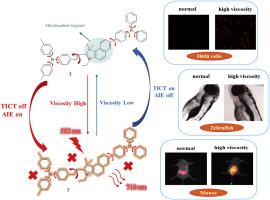基于聚集诱导发射的近红外荧光探针用于体内粘度成像
IF 4.2
3区 工程技术
Q2 CHEMISTRY, APPLIED
引用次数: 0
摘要
线粒体是细胞的能量源,其功能与细胞内外的物理化学环境密切相关。黏度在多个生理过程中对线粒体活动起着关键的调节作用。黏度异常不仅破坏线粒体功能,导致细胞能量代谢稳态失调,而且与多种病理机制密切相关。在此,我们创新地设计并合成了一种基于三苯胺支架的近红外荧光探针WG-1。荧光光谱表征表明,WG-1具有特殊的黏度响应特性,具有强的对数线性相关性(R12 = 0.99, R22 = 0.996),并具有明显的聚集诱导发射特性。值得注意的是,该探针具有出色的选择性和抗干扰能力,荧光信号不受pH和极性变化以及多种离子存在的影响。细胞实验表明,除了具有优异的生物相容性外,WG-1还能精确定位线粒体并动态跟踪粘度波动。体内实验进一步证实,WG-1能够实时监测斑马鱼的线粒体粘度,并在小鼠肝脏疾病模型中检测到显著的粘度响应信号。总之,WG-1为深入探索与线粒体粘度失调相关的疾病机制提供了一个强大的工具。本文章由计算机程序翻译,如有差异,请以英文原文为准。

Near-infrared fluorescent probe based on aggregation-induced emission for in vivo viscosity imaging
The functions of mitochondria, the powerhouses of the cell, depend intimately on the intracellular and extracellular physicochemical environment. Viscosity plays a critical regulatory role in mitochondrial activities across multiple physiological processes. Abnormal viscosity not only disrupts mitochondrial function, leading to dysregulation of cellular energy metabolism homeostasis, but is also closely associated with various pathological mechanisms. Herein, we innovatively designed and synthesized a near-infrared fluorescent probe, WG-1, based on a triphenylamine scaffold. Fluorescence spectral characterization revealed that WG-1 exhibits exceptional viscosity-responsive properties, a strong logarithmic linear correlation (R12 = 0.99, R22 = 0.996), and prominent aggregation-induced emission characteristics. Notably, the probe exhibited outstanding selectivity and anti-interference capability, with fluorescence signals remaining unaffected by changes in pH and polarity as well as the presence of diverse ions. Cellular experiments demonstrated that in addition to possessing excellent biocompatibility, WG-1 achieved precise mitochondrial localization and dynamic tracking of fluctuations in viscosity. In vivo experiments further verified that WG-1 enables the real-time monitoring of mitochondrial viscosity in zebrafish and detects notable viscosity-responsive signals in a murine liver disease model. Collectively, WG-1 provides a robust tool for in-depth exploration of disease mechanisms linked to mitochondrial viscosity dysregulation.
求助全文
通过发布文献求助,成功后即可免费获取论文全文。
去求助
来源期刊

Dyes and Pigments
工程技术-材料科学:纺织
CiteScore
8.20
自引率
13.30%
发文量
933
审稿时长
33 days
期刊介绍:
Dyes and Pigments covers the scientific and technical aspects of the chemistry and physics of dyes, pigments and their intermediates. Emphasis is placed on the properties of the colouring matters themselves rather than on their applications or the system in which they may be applied.
Thus the journal accepts research and review papers on the synthesis of dyes, pigments and intermediates, their physical or chemical properties, e.g. spectroscopic, surface, solution or solid state characteristics, the physical aspects of their preparation, e.g. precipitation, nucleation and growth, crystal formation, liquid crystalline characteristics, their photochemical, ecological or biological properties and the relationship between colour and chemical constitution. However, papers are considered which deal with the more fundamental aspects of colourant application and of the interactions of colourants with substrates or media.
The journal will interest a wide variety of workers in a range of disciplines whose work involves dyes, pigments and their intermediates, and provides a platform for investigators with common interests but diverse fields of activity such as cosmetics, reprographics, dye and pigment synthesis, medical research, polymers, etc.
 求助内容:
求助内容: 应助结果提醒方式:
应助结果提醒方式:


